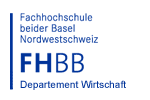E-fulfilment in the case of Coca-Cola Beverages AG
In many industries, the traditional roles of customers, suppliers and competitors can no longer be sharply differentiated from each other. The mutual dependencies in the distribution chain of Coca-Cola Switzerland demonstrate this graphically: The customers of the bottler are at the same time fulfilment partners for an e-commerce solution, via which re-sellers and consumers can order. This case study outlines how in one application different levels of the distribution chain are addressed and served with role-oriented functions.
1. The company
Products and division of labour within the group
Coca-Cola is the most famous consumer goods brand worldwide. In Switzerland, Coca-Cola has been bottled since 1936 and today has a market share of over 50% in the market for CSD (Carbonated Softdrinks/Fresh Water). Market development is apportioned according to a franchising system which is practised worldwide.
Coca-Cola Switzerland AG is a subsidiary of the Coca-Cola company in Atlanta and is the Swiss licensor for brands such as Coca-Cola, Fanta, Sprite and Nestea. Coca-Cola Schweiz AG owns the proprietary rights, sells the concentrate and conducts consumer marketing.
Coca-Cola Beverages AG (referred to below as “CCB” for short) is the only licensee for the production and distribution of Coca-Cola products in Switzerland. CCB produces the finished product, bottles it and is responsible for logistics, trade marketing and sales. CCB is a subsidiary of the European Coca-Cola Helenic Bottling Company “CCHBC” based in Athens, the second largest Coca-Cola licensee worldwide, to which the 24 European country companies belong. This case study highlights the fulfilment of CCB.
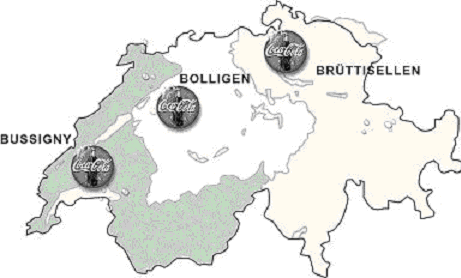
Fig. 1.1: Plant locations of Coca-Cola Beverages AG
Coca-cola drinks are bottled at 3 locations; over 800 employees in sales, production and logistics deal with a good 300 million litres a year, which is equivalent to a turnover of over 400 million CHF. The headquarters of CCB is in Dietlikon; all packaging formats are bottled and temporarily stored here. The total range is stored in Bolligen and Bussigny, but only part of it is bottled. CCB delivers its products from all locations, but region-wide development is, however, only achieved through the approximately 300 drinks wholesalers.
Industry, target group and corporate goals
CCB operates in the saturated soft drinks market. A multitude of sales channels with very varied requirements are served in a multi-tier distribution chain. The sales channels represent the final distribution tier where the consumer purchases the drink:
- Sales outlets of the grocery trade
- Restaurants and cafes
- Companies and offices
- Sports and entertainment
- Travel and transport
- Schools and universities
A distinction must ,however, be drawn between consumers and sales channels on the one hand and the sales channels of CCB on the other, which it supplies directly.
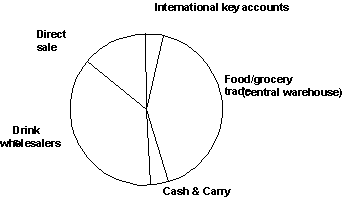
Fig. 1.2: Sales channels of Coca-Cola Beverages AG
In the role of market leader and innovator, CCB wants to achieve sustained growth, despite stagnating market volume in the alcohol-free drinks segment. The claim of taking up a leading position in the Swiss consumer goods industry and asserting itself as an important partner for the catering, drinks and grocery trade has led to the following operative plan thrusts:
- Efficiency increases in the value-added chain as a whole: systems and processes are to be utilised which meet future expectations and satisfy the high claims to safety and environmental compatibility.
- Innovative, strong trade marketing
2. e-business vision and e-business strategy
The importance of e-business is also derived from this self-decreed market positioning.
Coca-Cola Beverages AG also wants to assert the role of a leader and innovator in e-business as a professional partner for its customers. With the Coca-Cola shop as a service centre, added value is to be created for all partners involved, in that customers can order online, access information and services and make contact.
Strategy
The e-business strategy outlined below defines how benefit can be achieved in marketing and logistics. Prior to the concept presented here there was still no Internet service for CCB customers; the existing Coca-Cola Schweiz AG website www.coca-cola.ch is geared exclusively to consumers. While developing the e-business concept, CCB took on a pioneering role within Coca-Cola HBC, as no other country company in Europe had experience in this area.
Provider’s e-business concept
The e-business corporate concept of CCB was revised from spring 2000 over a period of approximately 6 months. As the impetus for this came from the marketing department, the CIO (Chief Information Officer) declared himself responsible for the specifics. The subsequent implementation partner aseantic also played a key role in the concept development. The concept was confirmed by the group holding company in Athens in autumn 2000. In addition to the operative advantages on the Swiss market, it is also intended as a pilot scheme for other countries. The aim is to gain the following insights from the experiences of Switzerland:
- How can customers be integrated into the efficient organisation of the overall logistics chain?
- Which new insights concerning customer needs can be gained from customer feedback on the functions offered?
- Establishment of a benchmark for e-commerce at Coca-Cola HBC
The concept focuses on an e-commerce solution that applies to all outsourced stages of the distribution chain – including consumers. The aim is not to bypass the existing distribution partners in the chain, but rather to support them with their sales. The solution is marked in grey in Fig. 2.1 and covers around half the distribution volume. It is obvious that a distinction must be made between four target groups in the e-commerce channel: the drinks wholesalers and a few restaurants are directly supplied customers. Indirect customers who are supplied by drinks wholesalers are other resellers and consumers who receive home deliveries.
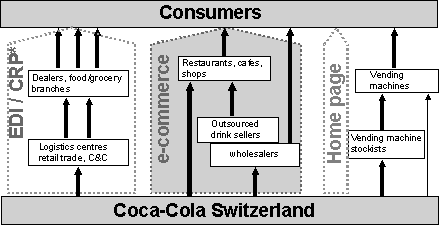
* EDI = Electronic Data Interchange, CRP = Continuous Replenishment
Fig. 3: e-business activity areas of Coca-Cola Switzerland
Scope of services
The e-commerce application distinguishes between the different distribution channels and offers tailor-made function modules for everyone (Tab. 2.2).
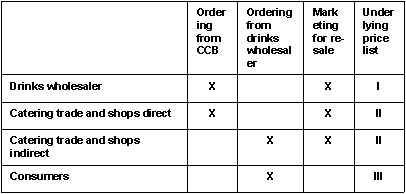
Tab. 2.2: Function/target group matrix
Drinks wholesalers and directly supplied resellers
Drinks wholesalers and a few restaurants and shops are supplied directly by CCB. The e-commerce application stores the registered buyers directly in the range mask, in which an order can be put together with a few clicks. Prices from two different lists are shown, i.e. either the prices for wholesalers or those for restaurants/shops. This method of handling price lists corresponds to the normal procedure from the offline channels. The actual invoice values depend on individual conditions stipulated in the basic agreements and the delivery costs; bonus agreements also exist. A net price calculation was dispensed with for reasons of complexity. In addition to individual shopping lists and the order history, the order process is supported by the selection of logistics units (euro pallet, shift) or sales units. In order to optimise logistics costs, the e-commerce application marks the items where the pallets are not fully loaded. The weight of the total consignment is shown. Drinks wholesalers have a choice between collection or delivery. Orders up until 12.00 am are delivered on the next working day or a later requested date by one of the three regional warehouses; the process is shown in Fig. 2.3. Order data is transferred to the ERP system several times an hour, and order processing and conventional postal billing are carried out there.

Fig. 2.3: Process chain for sales to direct CCB customers
The marketing support for the resellers is well-devised and detailed, reflecting the need for to excellent marketing across the entire distribution chain. It includes sales programmes and advisory elements for compiling the range and pricing, e.g. in restaurants. Pictures and lettering in different resolutions for different marketing applications can be downloaded for promotions. Carefully prepared and detailed information is also available – partly as instructions and partly as recommendations – for building up online product images, the so-called
E-merchandising guidelines (Fig. 2.4)
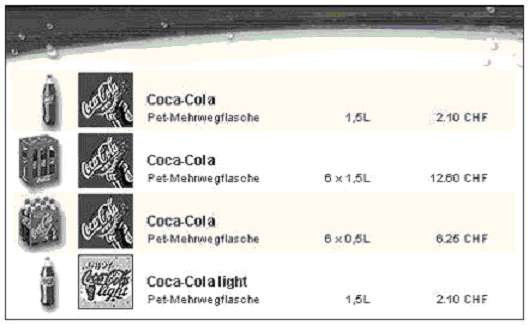
Fig. 2.4: Example for online product description from the e-merchandising guidelines
In addition to the order function and general information, the following added services are available:
- Information about current product offers
- Access to special sales programmes
- Access to POP articles (point of purchasing, cups, etc.) and to sales devices (cooler, vending machines, etc.)
- Depositing of personal shopping lists (range restrictions)
- Display of order history and the accumulated turnover with previous year comparison
- Statistics functions, designed to give CCB and the dealer precise marketing and efficiency control (implementation autumn 2001)
- Marketing support for printed matter, shops and individual online shops
Indirectly supplied resellersIndirect resellers, mainly restaurants and small shops, are supplied by the drinks wholesalers. They can register and find the same range of functions as wholesalers (Fig. 2.5).

Fig. 2.5: Process chain for sales to indirectly supplied resellers
They can input and maintain their own profile and they also see their previous online orders. Restrictions only arise where old data from the ERP system is not available, such as accumulated turnover, as the drinks seller prepares the invoice. Instead, there are channel-specific functions, such as the insertion of a regular drinks seller to which the orders are to be sent. In a free text field products can be ordered which do not originate from Coca-Cola, e.g. beer. Via the application, CCB now has direct contact with the indirectly supplied resellers and thus improved access to market information.
Consumers
As a service for drinks wholesalers, an order option for consumers has also been provided. Consumers are shown the list prices for home delivery services compiled by the Swiss Association of Drinks Wholesalers. After the shopping basket has been recorded, the consumer is offered a list of drinks wholesalers to choose from who have reached an agreement with CCB to deliver in their postcode area. In this agreement with CCB the wholesaler has made a commitment to observe a delivery time of 2 days and to conform to other service standards. The wholesaler chosen by the consumer carries out delivery, return of empties and debt collection according to its normal procedures; it steps in as franchise partner and processes the consumer’s purchase offer, which has merely been brokered by CCB. CCB offers fax, email and XML channels for the transfer of order data. In the first 4 months after the service was launched, none of the drinks sellers used the possibility of receiving XML-based orders. Online payment is not offered; the lean shop functionality provides neither registration nor other services over and above individual order brokerage.
Fig. 2.6: Process chain for sales to consumers
Partner
Internet agency
In an earlier phase, in which the licensor Coca-Cola Switzerland was looking for an Internet agency for a consumer-oriented winter promotion, the order was put out to tender amongst several agencies. Three providers were invited to fine-tuning workshop. The decision, with the inclusion of CCB, turned out to in favour of aseantic ag in Biel, above all due to their branch expertise. Admittedly, other providers were able to refer to excellent references for technical solutions or applications, e.g. in the finance industry, but aseantic, on the other hand, has detailed knowledge of the consumer goods market. This order was followed by another for the brand page www.coca-cola.ch. Thus, a relationship of trust developed, as a result of which aseantic was included in the concept development at CCB and significantly influenced it. Finally, aseantic also received the order for design and technical implementation. A cost ceiling was agreed during both the concept and the implementation phase.
Other partners
When working out the details of the CCB e-business application, a concept was found which reproduces the entire distribution chain with four different logistics processes without having to bring in other partners for the fulfilment:· e-commerce orders are no different to other orders received as regards order processing and collection. The process is controlled by the existing ERP system.· Payment for online orders is carried out after invoicing on the same terms as in the offline channels.· The further development and operation of the e-commerce application can be clearly separated from operation of the internal computer system, as only a limited data transfer is required, which is not effected in real-time. Thus, aseantic is also the only new business partner who had to be called in on account of the e-commerce application.
The e-commerce solution is a new medium for integrating direct and indirect customers who have been provided with an additional channel for orders. The establishment of new fulfilment instruments was consciously avoided.
3. Fulfillment solution
Like most brand article manufacturers, Coca-Cola does not sell directly to retail consumers. Thus, an e-commerce solution with direct B2C fulfilment can be ruled out. As previously described, the present solution provides fulfilment for resellers and retail consumers (home delivery service) through approximately 300 drinks wholesalers in Switzerland. These wholesalers take on delivery and collection with traditional instruments, controlled by the existing ERP system. The fulfilment with larger retail companies, with whom integrations exist through EDI systems, is not the subject of this case study.
Importance of the solution for fulfilment partners
Only a few drinks wholesalers have a website, let alone an e-shop. After the conclusion of an e-business agreement with CCB, in which the people in charge, the service standard and the postcodes of the wholesaler’s sales area are defined, the drinks wholesaler can receive orders from its customers via brokerage through the CCB e-commerce application. Drinks wholesalers do not incur any costs.
Three months after the launch, 20% of the target group have already ordered in the shop at least once. Further target group penetration is expected to be achieved in smaller steps, as the customers who are more open-minded naturally tend to figure in the group of Early Adopters. In interviews with some of the users, who described themselves as Internet beginners, the following representative set of opinions emerged with regard to the CCB solution:
- CCB is the first drinks supplier with an e-business solution; other projects are, however, also known in the industry
- The initiative is welcomed due to the build-up of experience connected with it; interviewees consider e-commerce to be relevant in the medium term
- Compared to the previous fax orders on forms, an Internet order takes longer, but people are prepared to take this onboard, as they are motivated by a CCB promotion and the learning effect
- The access to old data and product promotions is a popular feature
- Orders from customers have been very rare so far, a full range of drinks and not just the Coca-Cola range would be necessary for these
4. Implementation
Processes/redesign
During concept development, flow charts were used to start with, in which the new processes were reproduced. This type of representation is abstract and requires intensive participation by the decision-makers in order to be able to record the solution in its entirety. The breakthrough in the modelling process was achieved through a seventy-page Powerpoint simulation, which reproduced the user interaction one-to-one.
In order to be able to derive the delivery dates for the directly supplied customers from the route schedules of the three locations, harmonisations in the transport planning are necessary and this data must be made available in the application. Work is still being carried out on this process.
The sales department has included the new ordering channel in its operative targets. Every two months, the percentage of the Internet orders in the target is set. The success rate flows into the variable pay of the sales staff. Precise statistics are required for this fine tuning which can be prepared from the CCB sales information system.
Technical platform and architecture [System architecture]
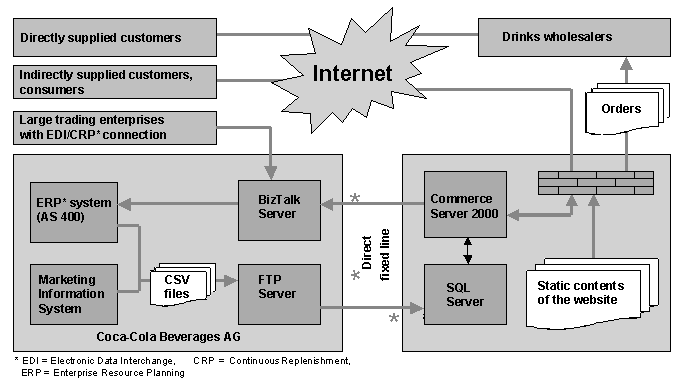
Fig. 4.1: Architecture of the e-commerce solution of Coca-Cola Beverages AG
Fig. 4.1 shows a diagram of the system architecture. For security reasons, CCB does not operate the web server itself and only allows strictly regulated access to its own ERP system. Control of the fulfilment services, delivery and invoicing are carried out in the AS 400 application; a Microsoft BizTalk server has been deployed as an interface to the Internet server. Owing to this specification and due to the experience available at aseantic, it was decided to use Microsoft products for the additional components, too. The MS Commerce Server 2000 was chosen because of its excellent value for money. The static contents and also access to the password management are maintained by aseantic the aid of the editing tool “Online Manager”. The “Jobs” category is reflected by the website www.coca-cola.ch. MS Windows 2000 is utilised as an operating system.
5. Operation
The application was put into operation on 1 April 2001 with the drinks wholesalers, the roll-out extended the target groups in the two subsequent quarters. Aseantic operates the web server, CCB is responsible for the leased telephone line, the BizTalk server and the FTP server. Two marketing employees now looking after marketing, operation and further development of the solution. They also cover user support, which takes 2 to 3 calls each day.
Viability
CCB does not publish any financial information on this project. In cooperation with aseantic, a comparative calculation was therefore drawn up for a project on this scale (Tab. 5.1). Specific project features of CCB are not included. On the plus side, CCB has chalked up savings from outsourcing to the electronic transaction channel, marketing advantages and the development of expertise.
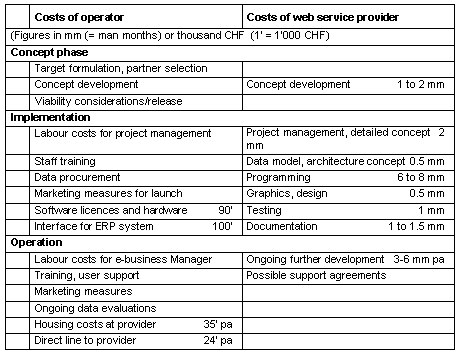
6. Success factors
Mr Studer, e-business manager at CCB cites the following success factors:
- A broad commitment to the project is necessary within the company.
- Detailed knowledge of corporate processes is essential as a basis for e-business and new processes must be thought out down to the last detail.
- Speed and short decision-making paths are necessary in the project. A full-time project manager from the operator is necessary from the outset as a competent contact person for the IT service provider.
- Project staff must be able to handle the very heterogeneous qualification of internal and external persons in relation to e-business. It is impossible to please everyone all of the time. Key members of staff have to be identified and integrated.
- It is advisable to raise customer needs in the concept phase. When developing the concrete functionalities, customers should not be included, however, in order to avoid the danger of raised expectations.
- For tests, internal personnel capacities and 5-10 pilot customers must be provided for checking the order process.
Specialities of the solution and the unique selling proposition
The CCB e-commerce solution stands out due to an efficient and user-friendly shop functionality and a lean fulfilment with recourse to existing instruments and market structures. The e-merchandising standards are a special feature of this e-business application. The feat has been achieved of reproducing various channels in a multi-tier distribution chain with a single application and of designing the tool so that all the partners involved benefit from it, without seeing themselves as being outdone by CCB.
Lessons learned
The fine-tuning and implementation of an e-commerce project is costly and time-consuming. The deadline and budget were met by CCB because the project team was on the one hand flexible and, on the other hand, they concentrated on core functions and were able to make decisions.



